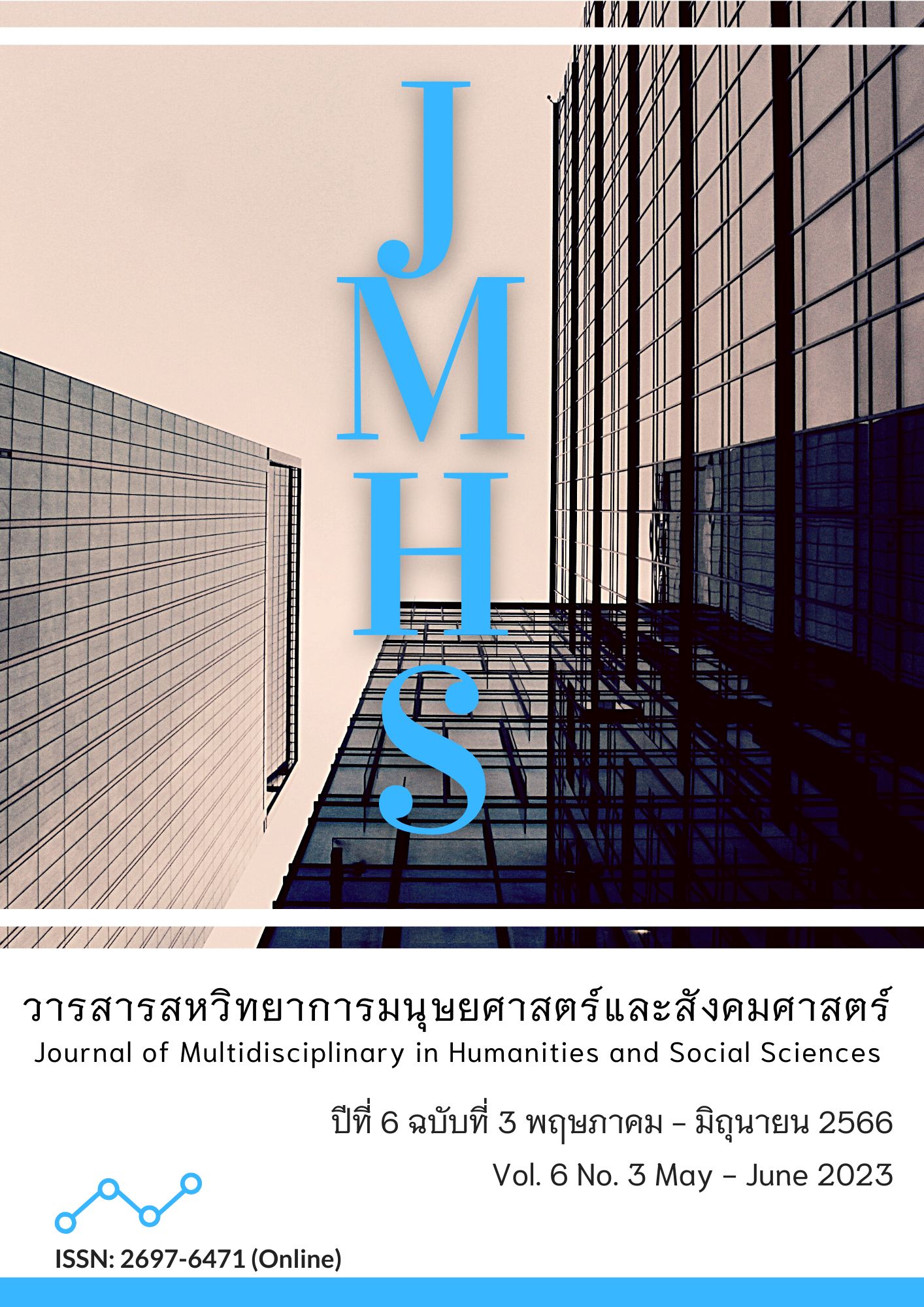Causal Factors Influencing Behavior to Buy Herbal Products on Facebook Page of Consumers in Bangkok and Its Vicinity
Main Article Content
Abstract
The article aimed to 1) develop and validate the consistency of the causal relationship model of behavior to buy herbal products on the Facebook page of consumers in Bangkok and its vicinity; and 2) study causal factors influencing behavior to buy herbal products on the Facebook page of consumers in Bangkok and its vicinity. This study was quantitative research. The sample consisted of people who had bought herbal products on the Facebook page and lived in Bangkok and its vicinity (357 people) by convenience sampling technique. The statistics used in data analysis were frequency, percentage, confirmatory factor analysis, and the structural equation model.
The results of this research were the development of causal relationship models consisting of 5 components: 1) product value; 2) voluntariness; 3) attitude; 4) subjective norm; and 5) behavior to buy. The model is consistent with the empirical data to a great extent. The statistics showed CMIN/df = 1.41, GFI = 0.94, AGFI = 0.90, SRMR = 0.02, and RMSEA = 0.03. The final predictive coefficient was 0.93, indicating that the variables in the model can explain the variance of behavior to buy herbal products on a Facebook page by 93 percent. It was found that the perception of subjective norms and attitudes were respectively influenced by the behavior of buying herbal products on the Facebook page. The results of this research are useful for entrepreneurs. Herbal products on Facebook pages can use the research results to market based on customer needs in order to create the behavior to buy herbal products in the future.
Article Details

This work is licensed under a Creative Commons Attribution-NonCommercial-NoDerivatives 4.0 International License.
Views and opinions appearing in the Journal it is the responsibility of the author of the article, and does not constitute the view and responsibility of the editorial team.
References
นฤมล ชูกันภัย, หุสนา มุกดา และ หรรษมน เพ็งหมาน. (2564). ทัศนคติและส่วนประสมทางการตลาดที่ส่งผลต่อการตัดสินใจซื้อสินค้าเฮ้าส์แบรนด์เทสโก้โลตัสของผู้บริโภคในจังหวัดสงขลา. วารสารเศรษฐศาสตร์และบริหารธุรกิจ, 14(1), 83-100.
นันทพร เขียนดวงจันทร์ และ ขวัญกมล ดอนขวา. (2562). ทัศนคติ และความตั้งใจที่มีอิทธิพลต่อพฤติกรรมผู้บริโภคในการซื้อสินค้าผ่านไลน์. วารสารเทคโนโลยีสุรนารี, 13(2), 58-78.
บุรฉัตร จันทร์แดง, เสาวลักษณ์ โกศลกิตติอัมพร และ สัญญา เคณาภูมิ. (2562). ปัจจัยที่มีผลต่อการเปลี่ยนแปลงพฤติกรรม. วารสารวิชาการธรรมทัศน์, 19(2), 235-244.
ปฐมาพร เนตินันทน์. (2562). ปัจจัยหลักของกลุ่มอ้างอิงในฐานะเครื่องมือสื่อสารตราสินค้าที่มีผลต่อพฤติกรรมการบริโภคของ “Gen Y”. วารสารปัญญาภิวัฒน์, 11(2), 291-308.
พระราชบัญญัติผลิตภัณฑ์สมุนไพร พ.ศ. 2562. สืบค้นเมื่อ 15 ตุลาคม 2565, จาก shorturl.at/tAH24
มณีรัตน์ แสงบุญไทย, สุขุมาล เกิดนอก และ วรญา โรจนาปภาพร. (2565). ปัจจัยเชิงสาเหตุที่มีอิทธิพลต่อการตั้งใจซื้ออาหารออร์แกนิคของผู้บริโภคในประเทศไทย. วารสารศิลปการจัดการ, 6(2), 621-636.
รุ่งนภา บริพนธ์มงคล. (2563). การรับรู้คุณภาพสินค้าและคุณภาพการบริการที่ส่งผลต่อการตัดสินใจซื้อซ้ำเครื่องทำความสะอาดอุตสาหกรรม. วารสารศิลปการจัดการ, 4(1), 166-179.
วิไลพรรณ วัฒนพงศ์ และ ฉันทนา ปาปัดถา. (2565). ทัศนคติที่ส่งผลต่อพฤติกรรมการเลือกบริโภคอาหารคลีนเพื่อสุขภาพในช่วงสถานการณ์ระบาดของไวรัสโคโรนา 2019 ในกรุงเทพมหานคร. วารสารวิชาการและวิจัย มทร.พระนคร สาขามนุษยศาสตร์และสังคมศาสตร์, 6(1), 34-49.
สุพัชรี เกิดสุข, พรรณรัตน์ แสงเพิ่ม และ ทัศนี ประสบกิตติคุณ. (2561). การคล้อยตามกลุ่มอ้างอิงและทัศนคติต่อการให้นมแม่ในที่สาธารณะของมารดาที่มีบุตรอายุ6-12 เดือน. วารสารสภาการพยาบาล, 33(3), 114-124.
สุมัยยา นาคนาวา. (2564). ทัศนคติ พฤติกรรม และส่วนผสมทางการตลาดที่มีความสัมพันธ์และส่งผลต่อทัศนคติการใช้บริการร้านอาหารฮาลาลของผู้บริโภคที่ไม่ใช่มุสลิม. วารสารวิทยาลัยดุสิตธานี, 15(1), 318-336.
สำนักงานพัฒนาธุรกรรมทางอิเล็กทรอนิกส์. (2565). รายงานผลการสำรวจพฤติกรรมผู้ใช้อินเทอร์เน็ตในประเทศไทย ปี 2565. สืบค้นเมื่อ 15 ตุลาคม 2565, จาก shorturl.at/drQS5
ศูนย์วิจัยกสิกรไทย. (2562). ถึงเวลาโกยเงิน SME รุกตลาดสมุนไพร. สืบค้นเมื่อ 15 ตุลาคม 2565, จาก https://t.ly/MxWx
ศูนย์วิจัยกสิกรไทย. (2563). กระแสรักสุขภาพจากโควิดสร้างโอกาสธุรกิจ SME. สืบค้นเมื่อ 15 ตุลาคม 2565, จาก shorturl.at/bpJX9
อภิลักษณ์ ธรรมวิมุตติ และ ประสพชัย พสุนนท์. (2559). อิทธิพลของทัศนคติ การคล้อยตามบรรทัดฐานของกลุ่มอ้างอิง การควบคุมพฤติกรรมและบุคลิกภาพแบบเปิดเผยที่มีต่อพฤติกรรมการดื่มเครื่องดื่มแอลกอฮอล์ของนักศึกษาหญิงระดับปริญญาตรี มหาวิทยาลัยราชภัฏกลุ่มภูมิภาคตะวันตก. วารสารอิเล็กทรอนิกส์, มหาวิทยาลัยศิลปากร, 9(1), 1533-1548.
Demetillo, A.M. (2019). Simple Voluntariness. Retrieved February 25, 2023, from https://www.scribd.com/document/515953691/1#
Forgeard, V. (2022, March 26). Why Are Voluntariness and Responsibility Important. Retrieved February 25, 2023, from https://brilliantio.com/why-are-voluntariness-and-responsibility-important/
Hair, J.F., Black, W.C., Babin, B.J., & Anderson, R.E. (2010). Multivariate Data Analysis (7th ed.). Upper Saddle River, NJ: Prentice Hall.
Hair, J.F., Hult, G.T.M., Ringle, C.M., & Sarstedt, M. (2014). A Primer on Partial Least Squares Structural Equation Modeling (PLS-SEM). California, CA: Sage Publications.
Hoelter, J.W. (1983). The Effects of Role Evaluation and Commitment on Identity Salience. Social Psychology Quarterly, 46(2), 140–147.
Hu, L.T., & Bentler, P.M. (1999). Cutoff Criteria for Fit Indexes in Covariance Structure Analysis: Conventional Criteria Versus New Alternatives. Structural Equation Modeling, 6(1), 1–55.
Jang, Ha-Won., & Cho, Meehee. (2022). The relationship between ugly food value and consumers’ behavioral intentions: Application of the Theory of Reasoned Action. Journal of Hospitality and Tourism Management, 50, 259–266. https://doi.org/10.1016/j.jhtm.2022.02.009.
Joreskog, K.G., & Sorbom, D. (1984). Advances in Factor Analysis and Structural Equation Models. Lanham: Rowman & Littlefield Publishers.
Kline, R.B. (2011). Principles and Practices of Structural Equation Modeling. New York: The Guilford Press.
Kokila, V., & Sampathlakshmi, N. (2020). Review Paper on the Influence of Subjective Norms on the Pre-Purchase Behavior of Electronic Products – An Indian Narrative. International Journal of Management, 11(9), 1145-1151.
Lestari, I., Chaniago, S., Azzahra, S., & Effendi, I. (2019). Trust Identification and Smartphone Purchase Decisions (Structural Equation Modeling Approach). International Journal of Civil Engineering and Technology, 10(2), 1020-1032.
Li, M. (2018). Factors Influencing Customer Repurchase Intention by using Third-party Platform Booking Flight Ticket in China. (Master of Business Administration). The University of the Thai Chamber of Commerce.
Schreiber, J.B., Stage, F.K., King, J., Nora, A., & Barlow, E. A. (2006). Reporting Structural Equation Modeling and Confirmatory Factor Analysis Results: A Review. The Journal of Educational Research, 99(6), 323–337.
Schumacker, R.E., & Lomax, R.G. (2004). A Beginner's Guide to Structural Equation Modeling. (2nd ed.). Lawrence Erlbaum Associates Publishers.
Thompson, B. (2004). Exploratory and Confirmatory Factor Analysis: Understanding Concepts and Applications. American Psychological Association.
Ullman, M.T. (2001). The declarative/procedural Model of Lexicon and Grammar. Journal of Psycholinguistic Research, 30(1), 37–69.
Wolf, L.J., Haddock, G., & Maio, G.R. (2020). Attitudes. Oxford Research Encyclopedias. Retrieved February 25, 2023, from https://doi.org/10.1093/acrefore/9780190236557.013.247


